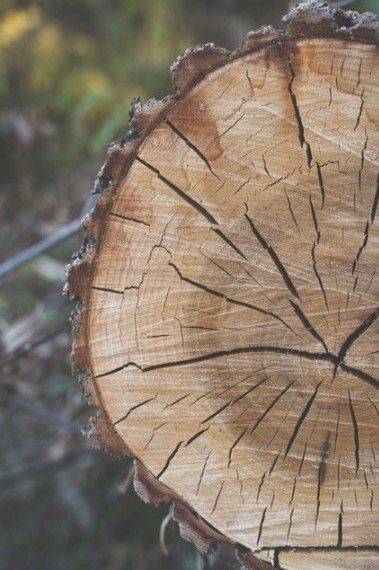Tree Rings Tell an Ongoing Story of Growth, Rest, Resilience, and New Life
May 1
/
Terri Conlin

It all began with bookends my grandson made for me – tree slices, quartered, sanded, and shellacked with the birch bark in all its glory.
I adored them simply because Crosby's six-year-old hands made them with our names scrawled together on the bottom perfectly backward. Soon, I was noticing every ring, radiating crack and scar.
Tree rings record the honest story of the tree's life along a timeline. Each annual ring holds two rings in a full cycle of formative growth - a light one indicating robust growth during spring and early summer when leaves were green during active photosynthesis, and a dark one indicating slower growth later in summer and autumn when leaves fell, and photosynthesis stilled. ¹
Tree rings tell us so much more than age. They also record patterns of wind, storm, drought, stress, and damage from insects and fire. Tree ring science, known as dendrochronology, includes a wide range of data reconstructed from a larger picture of a tree's life within climate, archeology, and ecology across time beyond their lifespan. ²
The longer I lingered with the complexity of the beauty and pain tree rings held, the more they became a metaphor for my spiritual life and what happens during prayer and spiritual direction when we hold God's loving gaze.
I explored with my spiritual director what felt like thick rough patches in my bark, too overly protective for the deep connection I longed for with God, others, and myself. As the Spirit moved to deeper rings, I noticed several old wounds with layered defenses I had built as protection. Initially, I wanted to judge my behavior, but looking alongside trusted spiritual companions, bringing all we saw into the light of Christ, allowed me a longer look with more tenderness. My protections had served their purposes, and now, though I certainly felt the vulnerability of exposure, I wanted to release my guardedness.
Macrina Wiederkehr describes a kind of beauty in exposure,
"I love the way winter stands there saying, "I dare you not to notice my beauty." What can I say to a winter tree when I am able to see the shape of its soul because it has finally let go of its protective leaves?" ³
When examining a crosscut tree, I do not judge it for its survival and resilience. I see beauty in the record of its life, including the scars it took to survive; for example, the blue stain where a beetle invaded and the resulting red stain from the tree's natural defense.
A similar story plays out in spiritual direction. I suspend judgment and look with tender awe at the hidden beauty of a difficult journey, noticing the bravery, beauty, vulnerability, and hidden strength of a new sound emerging.
Luthier Martin Schelske describes listening to both the grain and arch of the wood when making violins and connects that to a Spirit-filled faith in a loving Artist,
"Faith means to trust in the indwelling wisdom of the Creator and the promised possibilities while still acknowledging, even embracing, the history of the wood that is now essential to the unfolding of its sound. The wood finds its own voice in being born again." ⁴
In spiritual direction, we are looking for more than the record of what once happened. We are opening to the creative presence of the loving Trinity community throughout, not only in the surface and obvious but in hidden and surprising places. When we look together, we discover Jesus, perhaps where we missed him before we risked taking a longer loving look.
While we are looking for Jesus, we find him looking for us. And he goes deeper, inviting us to look back at him, including his wounds. In Luke's gospel, after walking with two disciples on the road, the risen Jesus shows up and invites his disciples, "Look at my hands; look at my feet – it's really me. Touch me. Look me over from head to toe."
Meditating on Jesus' invitation, I felt the truth in artist Bryan Nash Gill's words,
"I found that things were as or more beautiful and complex inside than what was visible from the outside . . . You never know what you're missing if you don't find some way to get inside and look." ⁵
Considering tree rings as a metaphor for encountering God's love right where I am is helping me embrace all my seasons, robust growth together with slow rest and wounds as well, and count them all as growth, take longer loving looks at my life and others' with deep awe and mercy, and accept Jesus' wild invitation to touch his wounds and trust mine to his shaping hands.
Notes
¹ (National Oceanic and Atmospheric Administration, 2016)
² (Robbins, 2019)
³ (Wiederkehr, 1988, p. 93)
⁴ (Schleske, 2020, p. 98)
⁵ (Gill, 2023)
Bibliography
Gill, B. N. (2023, April 24). Bryan Nash Gill. Retrieved from Bryan Nash Gill:
https://www.bryannashgill.com/about-bryan
National Oceanic and Atmospheric Administration. (2016, August 11). Retrieved from National Centers for Environmental Information:
https://www.ncei.noaa.gov/news/how-can-tree-rings-teach-us-about-climate
Robbins, J. (2019, April 30). New York Times. Retrieved from New York Times:
https://www.nytimes.com/2019/04/30/science/tree-rings-climate.html
Schleske, M. (2020). The Sound of Life's Unspeakable Beauty. Grand Rapids:
Eerdeman's.
Wiederkehr, M. (1988). A Tree Full of Angels. New York City: Harper Collins.

Terri Conlin
Terri Conlin is a certified Spiritual Director, writer, and occasional preacher. She has a BA in Architecture from the University of Texas at Austin and a MA in Spiritual Formation from Portland Seminary. She thrives when creativity and resilience flourish together in God’s sheltering places. Terri and her husband live among the rainy firs of Oregon. They have four grown children and seven feisty grandchildren she calls the Wonders. Most days you can find her outside walking or writing about spiritual formation while sipping dark roast coffee in a thrifted mug. https://www.terriconlin.com/
Terri Conlin is a certified Spiritual Director, writer, and occasional preacher. She has a BA in Architecture from the University of Texas at Austin and a MA in Spiritual Formation from Portland Seminary. She thrives when creativity and resilience flourish together in God’s sheltering places. Terri and her husband live among the rainy firs of Oregon. They have four grown children and seven feisty grandchildren she calls the Wonders. Most days you can find her outside walking or writing about spiritual formation while sipping dark roast coffee in a thrifted mug. https://www.terriconlin.com/

